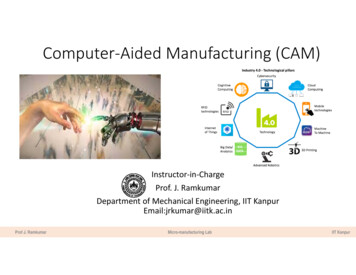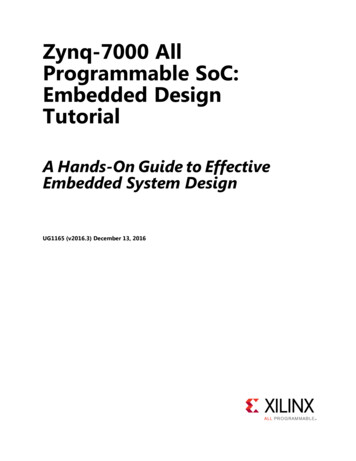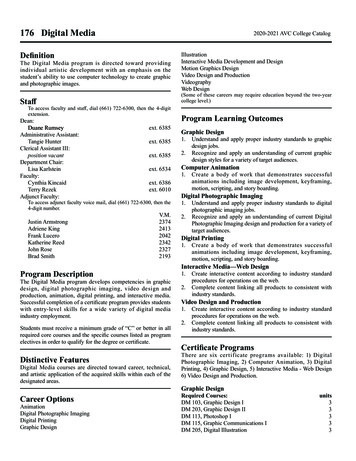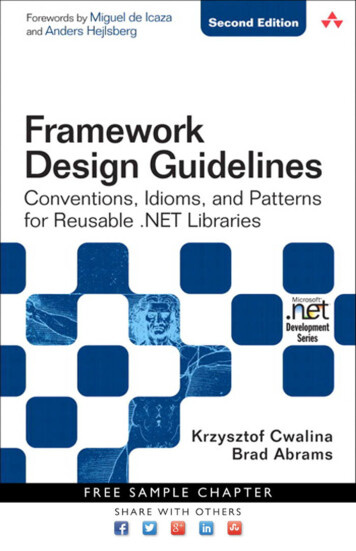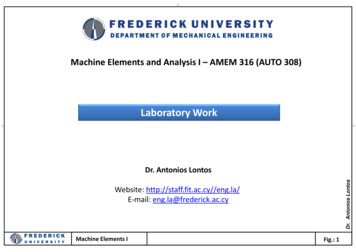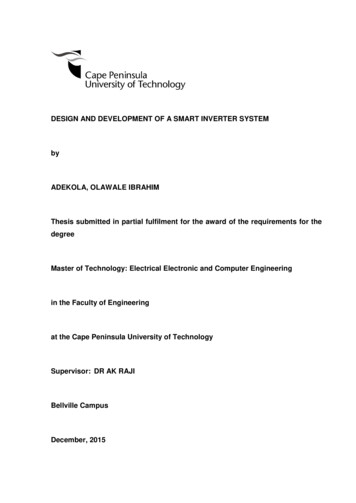
Transcription
DESIGN AND DEVELOPMENT OF A SMART INVERTER SYSTEMbyADEKOLA, OLAWALE IBRAHIMThesis submitted in partial fulfilment for the award of the requirements for thedegreeMaster of Technology: Electrical Electronic and Computer Engineeringin the Faculty of Engineeringat the Cape Peninsula University of TechnologySupervisor: DR AK RAJIBellville CampusDecember, 2015
CPUT copyright informationThis dissertation/thesis may not be published either in part (in scholarly, scientific or technicaljournals), or as a whole (as a monograph), unless permission has been obtained from theUniversity.i
DECLARATIONI, Olawale Ibrahim ADEKOLA, declare that the contents of this dissertation/thesis representmy own unaided work, and that the dissertation/thesis has not previously been submitted foracademic examination towards any qualification. Furthermore, it represents my own opinionsand not necessarily those of the Cape Peninsula University of Technology.SignedDateii
ABSTRACTThe growing interest in the use of solar energy to mitigate climate change, reduction in thecost of PV system and other favourable factors have increased the penetration of thePV(Photovoltaic) systems in the market and increase in the worldwide energy supply. Themain component in a DG is a smart inverter connected in a grid-tied mode which serves as adirect interface between the grid and the RES (Renewable Energy System).This research work presents a three phase grid-tied inverter with active and reactive powercontrol capabilities for renewable energy sources (RES) and distributed generators (DG).The type of the inverter to be designed is a Voltage Source Inverter (VSI). The VSI iscapable of supplying energy to the utility grid with a well regulated DC link at its input.The solution this project proposes is an implementation of the designed filter to effectivelyreduce the harmonics injected into the grid to an acceptable value according to standardsand also an approach to control the real and reactive power output of the inverters to helpsolve the problems of instability and power quality of the distribution system. The design,modelling and simulation of the smart inverter system is performed in MATLAB/SIMULINKsoftware environment. A 10 kW three-phase voltage source inverter system connected tothe utility grid was considered for this research. Series of simulations for the grid-connectedinverter (GCI) model was carried out using different step changes in active and reactivepower references which was used to obtain the tracking response of the set powerreferences. The effectiveness of the control system which was designed to track the setreferences and supply improved power quality with reduced current ripples has been verifiedfrom the simulation results obtained.iii
ACKNOWLEDGMENTS I wish to thank Almighty Allah for giving me the opportunity and strength to effectivelycarry out my research work. My sincere appreciation goes to my supervisor Dr A.K Raji for his support,supervision and guidance. His mentoring and motivation has facilitated me incompleting this research work. I would also like to express my profound gratitude to my beloved parents, Prof and Dr(Mrs) ADEKOLA, for their endless love and affection showed to me during mytoughest and most trying period. I will also like to appreciate my siblings, Tola, Kamal, Mariam, Abdullahi andAbdulrahman as well for their moral support. May Allah reward you abundantly(Amin). My sincere gratitude also goes to the members of Faculty of Engineering: Akim, John,Martial, Makani, kunle, Clement, Khader, Alli and Al-jadeed for their support andhelpful suggestions during my Master’s program. My gratitude goes to Seyi, Qazeem, Aisha, Bukola, Damola, Benji, Sodiq, Afolabi, Ife,Mumba and others just to mention a few for helping me in one way or the other.God’s blessings shall not depart from you all.iv
TABLE OF CONTENTSCPUT copyright information . iDECLARATION . iiABSTRACT . iiiACKNOWLEDGMENTS . ivTABLE OF CONTENTS . vLIST OF FIGURES . xLIST OF TABLES . xivDEDICATION. xvRESEARCH OUTPUTS . xviLIST OF ABBREVIATIONS. xviiGLOSSARY OF TERMS . xixLIST OF SYMBOLS . xxCHAPTER 1 . 1INTRODUCTION . 11.1Background . 11.2Benefits of Using the Renewable Energy Systems . 41.3Smart Inverters . 41.4The Smart Grid . 61.5Statement of the research problem . 71.6Justification for the research . 71.7Objectives of the research . 81.8Delineation of the research . 91.9Outline of thesis . 9CHAPTER 2 . 10LITERATURE REVIEW . 102.1Introduction . 102.2PV Array Model . 112.3Classification of Inverters . 13v
2.3.1Classification of Inverter Based on The Type of Power Source: . 132.3.2Classification of inverter structure or topology:. 142.3.3Classification of Inverter Configurations . 162.4Topologies of grid-connected inverter configurations . 182.4.1Central Inverters . 182.4.2String Inverters . 192.4.3Multi-String Inverters. 192.4.4Module Inverter System (Micro Inverters) . 202.4.5Transformerless AC Module Inverters (Module Integrated PV Converters) . 202.4.6Transformerless Single-stage String Inverters . 212.4.7DC-Module Converters in Transformerless Double-Stage PV Systems . 212.5Modes of operation of Inverter . 212.5.1Grid-Connected Mode . 212.5.2Stand-Alone Mode (Off-Grid System) . 232.6PV Technology . 242.7International Standards for Grid-Connected Systems and DES . 252.8Electricity demand and generation developments . 272.9Energy Storage in Distributed Energy Source (DES) . 302.10Role of a Smart Grid . 312.11Advantages and Applications of Solar Energy in Generating Electricity . 312.12Demands for Grid-Connected Photovoltaic Systems . 322.13Problems related to PV Array connection to the Grid . 332.14Harmonics . 342.14.1Harmonic Effects . 352.14.2Harmonic Filtering . 352.15Filter Topology . 372.15.1L Filter (First-order): . 382.15.2LC Filter (Second-order): . 392.15.3LCL Filter (Third-order): . 402.16Maximum Power Point Tracking . 41vi
2.17EMI Problems . 422.18Non-Controlled Grid Connected Inverter . 422.19Control Strategies Used In Grid-Connected Inverter . 432.19.1CSI Controls . 442.19.2PQ (Active Power-Reactive Power) Controls . 442.19.3VSI Controls . 452.20Summary of Grid Synchronization Methods . 532.20.1Grid Voltages Filtering Technique . 542.20.2Zero-Crossing Technique . 552.20.3PLL (Phase-locked loop) Technique . 552.21Control Structures Evaluation . 562.22Pulse Width Modulation . 562.22.1Sinusoidal Pulse Width Modulation (SPWM). 572.23Power Quality Issues . 612.24Anti-Islanding . 612.25Conclusion . 62CHAPTER 3 . 63POWER ELECTRONICS TECHNOLOGY . 633.1Introduction . 633.2Power Electronic Converter Systems . 633.2.13.3Applications of Power Electronic Converters in Power Systems . 64Semiconductor-Device Technology . 663.3.13.4Power Semiconductor Switches. 67Classification of Switch . 683.4.1Uncontrollable Switches . 683.4.2Semi-controllable Switches . 693.4.3Fully Controllable Switches . 703.4.4Unidirectional Switch . 753.4.5Reverse Conducting Switch . 753.4.6Bidirectional Switch. 76vii
3.5Voltage Source Inverters (VSI) . 763.6Fundamental Configurations . 773.6.1Single Phase Inverters. 773.6.2Three Phase Bridge Inverters . 793.6.3Multi-module VSI Systems . 803.7Conclusion . 81CHAPTER 4 . 82MODELLING AND ANALYSIS . 824.1Objective . 824.2DC Energy source . 834.2.1DC Link Voltage Design . 854.3The Inverter model. 854.4Output filter . 884.4.1Modelling and Design of LCL filter . 894.4.2Frequency Response and Transfer Function . 924.4.3LCL Filter Design procedure . 924.5The Three-Phase grid-connected inverter synchronization . 984.5.1GCI Synchronization using PLL (Phase Locked Loop) Technique . 984.5.2Design of Synchronous Reference Frame PLL . 1004.6The Three-Phase grid-connected VSI control technique . 1024.6.1Model of Current controller . 1034.6.2Design of PI-Based Current Control Scheme . 1054.7Conclusion . 112CHAPTER 5 . 113SIMULATION RESULTS AND DISCUSION . 1135.1Introduction . 1135.2Grid-connected inverter . 1135.3Simulation Results . 1155.3.1System performance with step reference change in active and reactive power . 126viii
5.3.25.4Bidirectional flow of power from the Utility grid to dc-link . 140Conclusion . 147CHAPTER 6 . 148CONCLUSION AND FUTURE WORK . 1486.1Conclusion . 1486.2Future work. 148REFERENCES . 149APPENDICES. 164ix
LIST OF FIGURESFigure 1.1: Energy mix in South Africa . 1Figure 1.2: Cost reduction curve for renewable energy technology . 2Figure 1.3: World market share of standard inverter and smart inverter graph . 3Figure 2.1: Experimental block diagram of the smart inverter system . 11Figure 2.2: Representation of a PV Panel . 12Figure 2.3: General classification of MFI Based on Circuit Power Structure . 14Figure 2.4: Topology of grid connected system: (a) Current Source inverter . 15Figure 2.5: Voltage source inverter . 16Figure 2.6: Topology of grid-connected system: (a) Z Source inverter . 16Figure 2.7a: Configuration of different PV application circumstances (a) single-stagestructure. 17Figure 2.7b: Two-stage structure . 17Figure 2.7c: Multi-Stage Inverter . 18Figure 2.8: PV grid connected systems configurations a. Central Inverterb. string Inverterc. Multi-string Inverter d. Module Inverter. 20Figure 2.9a: Representation of grid-connected mode inverter operation . 23Figure 2.9b: Representation of standalone inverter operation . 23Figure 2.10; Growth and installation of solar PV energy in various countries . 29Figure 2.11: Grid-connected system of Energy storage device . 31Figure 2.12: Configuration of L filter . 39Figure 2.13: Configuration of LC filter . 40Figure 2.14: configuration of LCL filter . 41Figure 2.15: Electrical model of PV system with non-controlled inverter connected to the grid. 43Figure 2.16: Classification of current control methods . 47Figure 2.17: Typical structure of a stationary reference frame. 49Figure 2.18: Representative structure of a rotating reference frame. 50Figure 2.19: Representative structure of a natural reference frame. 51Figure 2.20a Synchronization method using filtering on the dq synchronous rotatingreference frame . 54Figure 2.20b: Synchronization method using filtering on the 𝜶𝜷 stationary reference frame 54Figure 2.21: Representation of three phase dq PLL method . 56Figure 2.22a: Schematic representation of the mechanism of generating PWM gating pulsesfor inverter switches in Simulink . 59Figure 2.22b: Three-phase VSI system with SPWM . 60Figure 2.22c: Sinusoidal PWM for three phase VSI . 60x
Figure 3.1: PV energy applications. (a) grid-connected application (b) power supplyapplication . 67Figure 3.2: Diode symbol and volt-ampere characteristics . 69Figure 3.3: Thyristor symbol. 70Figure 3.4: MOSFET symbol. 71Figure 3.5: Symbol of a GTO . 72Figure 3.6: The IGBT; (a) the schematic symbol (b) Equivalent circuit . 74Figure 3.7: a) basic representation of a switch cell. b) Symbolic illustrations of a switch cell 76Figure 3.8: Schematic of the half-bridge, single-phase, two-level VSI . 78Figure 3.9: Schematic of the full-bridge, single-phase, two-level VSC (or an H-bridgeconverter) . 78Figure 3.10: Schematic representation of the three-wire, three-phase, two-level VSI (b) thesymbolic representation of the three-phase VSI. . 79Figure 3.11: Representation of the symbols of valve made up of (a) m parallel-connectedswitch cells and (b) k series-connected switch cells. (Yazdani & Iravani 2010) . 81Figure 4.1: Three Phase Grid-Connected Inverter System with Control AlgorithmRepresentation . 83Figure 4.2: Equivalent circuit of a PV cell and its characteristics . 83Figure 4.3: Bidirectional DC to AC PWM VSI . 86Figure 4.4: Three phase grid-connected scheme . 88Figure 4.5: Model of LCL filter per phase . 90Figure 4.6: Representation of LCL filter model for three-phase VSI . 92Figure 4.7: Ripple attenuation as a function of the ratio between the grid to inverterinductances . 93Figure 4.8: Flow chart representation of LCL filter design algorithm . 94Figure 4.9: PLL representation in synchronous reference frame . 99Figure 4.10: Linearized PLL system representation . 100Figure 4.11: Control block representation of the current controlled VSI . 105Figure 4.12: PI controller configuration . 106Figure 4.13: Block representation of current control loop . 107Figure 4.14: Current control loop step response . 111Figure 4.15: Current control loop frequency response. 112Figure 5.1: Grid-connected VSI model in Simulink . 114Figure 5.2: Current control system of the grid connected VSI in Simulink . 114Figure 5.3: Linearized model of grid-connected VSI . 115Figure 5.4: inverter switched phase voltage Va before the filter . 116Figure 5.5: Inverter output current ia . 117Figure 5.6: Inverter filtered output current of three-phase grid-connected inverter . 118xi
Figure 5.7: Inverter filtered output voltage of three-phase grid-connected inverter . 118Figure 5.8: Phase voltage Va and grid current ia . 119Figure 5.9: Phase voltage Va and phase angle . 119Figure 5.10: Active power 'P' injected into the grid . 120Figure 5.11: Reactive power 'Q' injected into the grid. 120Figure 5.12: id current response to reference command . 121Figure 5.13: Current control loop error for id current . 122Figure 5.14: iq current response to reference command . 122Figure 5.15: current control loop error for iq component . 123Figure 5.16: d and q components of voltage measured. 124Figure 5.17: d and q components of the modulating signals directed to the PWM. 124Figure 5.18: Modulation index . 125Figure 5.19: FFT Analysis showing THD of line current injected to the grid. 126Figure 5.20: Inverter output current ia . 127Figure 5.21: Grid current response to change in reference command of active and reactivepower . 127Figure 5.22: Phase voltage and grid current response to change in step reference commandof active and reactive power . 128Figure 5.23: Active power 'P' injected into the grid . 129Figure 5.24: Reactive power 'Q' injected into the grid. 129Figure 5.25: id current response to change in reference command . 130Figure 5.26: current control loop error for id current . 130Figure 5.27: iq current response to change in reference command . 131Figure 5.28: Current control loop error for iq current . 131Figure 5.29: d and q components of voltage measured. 132Figure 5.30: d and q components of the modulating signals directed to the PWM. 133Figure 5.31: FFT Analysis showing THD of line current injected to the grid . 133Figure 5.32: Inverter output current ia . 134Figure 5.33: Grid current response to change in reference command of active and reactivepower .
main component in a DG is a smart inverter connected in a grid-tied mode which serves as a direct interface between the grid and the RES (Renewable Energy System). This research work presents a three phase grid-tied inverter with active and reactive power control capabilities for renewable energy sources (RES) and distributed generators (DG).



